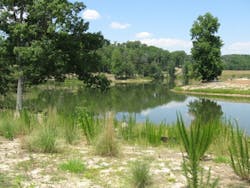Best Management Practices (BMPs): The Design Element
Part 1 of a three-part series on stormwater Best Management Practices
As the implementation of water quality rules and regulations has become prevalent, the use of BMPs has become the preferred method of reducing the pollutants entering our nation's waters. Almost every jurisdiction has a manual with approved BMPs that features an assumed level of performance. Essentially, the concept is to remove 80% of the offending materials (or a surrogate, such as total suspended solids) by applying one or more of the BMPs listed in the manual. Some of the practices are assigned an 80% removal rate and are good as a stand-alone solution, and others are assigned smaller percentages, and must be part of a series or group of BMPs that "add up" to at least 80% removal. If the numbers add up, the design is approved. While this is a convenient way to issue permits, it certainly is not a design strategy. There are good reasons why this approach does not work. The most obvious of these is the fact that all sites are not created equal.
A one-acre dentist's office may have exactly the same amount of roof, paving, and landscaping as a one-acre gas station/convenience store, but the usage of the two sites is vastly different. The amount of traffic, the nature of the services provided, the amount of pedestrian traffic, and the nature of materials stored or discharged to the surfaces are completely different. Nevertheless, if the same BMPs are applied "by the book," the water quality treatment systems might be identical. Clearly, using performance ratings for standard practices that are assumed to be equal on all sites is the wrong approach. If this is true, how is a good design to be accomplished for each individual site?
The first step is to recognize that removing total suspended solids (TSS) is simply a surrogate for implementing good water quality practices. There are actually six basic categories of pollutants that should be dealt with on every site. The nature of these materials varies from site to site, as does the amount of each material. The basic categories are: dissolved chemicals, true suspensions, oil and hydrocarbons, trash and debris, organic materials and sediments. As a mental exercise, if we take each category and think about how the types and amounts of pollutants under each one would vary greatly on a dentist's office versus a gas station/convenience store, we can see how effective designs for these two uses should not be identical.
In a nutshell, here are the steps required for a proper design:
Second, decide which BMPs would address the pollutants of concern and where they should be located. For an isolated source, such as a gas island, perhaps overhead protection from rainfall coupled with a treatment element at one point could stop hydrocarbons before they enter the rest of the system and co-mingle with the rest of the water. For a general source, such as dissolved chemicals, fertilizers and pesticides, perhaps at location downstream of all other BMPs detention might be in order. As a part of the location decision, there should be some consideration given to whether a BMP should stay on-line for all flows or should bypass everything except the defined water quality flow. While it is true that some of the constituents move early in a storm and at low flows (dissolved chemicals and tiny particles), others move only in higher flows or are distributed over a wide range of flows.
Finally, once it's been determined what the pollutants are, and where the proper BMPs should be located, it is important to look at the overall design concept for the site. This is presented here as a final step but it really is the beginning of the process of taking the concepts developed in the first two steps, and implementing them into an actual site design. Physical constraints will dictate some elements of design but there are overreaching principles that should be considered and may dictate changes.
First, look at ways to prevent pollutants from mixing with stormwater in the first place. For example, is it necessary to run relatively clean water from roof drains across a parking lot? Next, look at water quantity control in light of the known pollutants and methods of control. This is essentially how Low Impact Development (LID) is integrated into a site design. Often, elements that control water quantity, such as cisterns, infiltration, or other on-site re-use, will result in better water quality.
Consider this process on the hypothetical gas station/convenience store. We expect hydrocarbons will be spilled in this operation incidentally or perhaps in a large quantity from an accident. High traffic counts will mean a high sediment load, and lots of trash and debris will be encountered. This is not a highly landscaped site, so the threat of excess nutrients is less likely. We know that we can use a spill-trapping BMP and that sediments and trash are easy to address. Now we look at ways to use LID to make everything easier. We take the roof water from the store and put it into a cistern with minimal treatment (it should be pretty clean) to use for irrigation and wash down. This will make every element in the drainage system smaller and will make the flow rates lower. We cover the gas dispensing operation and grade it to prevent water from outside the canopy from running over the area. Now, we can isolate the spill potential and treat it locally before it enters the main drainage flow. We incorporate a trash-screening separator into the system above a wet detention pond so that it does not become impacted with excess sediments, nutrients and trash. This pond and the pipes leading to it are smaller because of the water we have diverted to the cistern. The savings here, as well as the savings generated from not buying water to irrigate the landscape, may help pay for the cistern. Having saved a bit of land by using a smaller pond, perhaps we have room for a small infiltration field (soils permitting) located after the pond. This would use water slowly routed from the pond after all the other forms of treatment and certainly would not be "on-line" for all flows, especially high flow containing hydrocarbons, sediments and debris.
Does this seem like a better approach than picking a standard BMP flat-rated at 80% TSS removal from a manual? Of course it is -- and it might actually be less expensive than the "standard" approach. We have learned much over the past two decades and it is time to put this knowledge to use in our designs in a way that is practical, sustainable, and affordable.
Read part 2 > Best Management Practices (BMPs): The Installation Element
Read part 3 > Best Management Practices (BMPs): The Maintenance Element
About the Author: John Moll is the CEO of CrystalStream Technologies, and is an active researcher in the water quality field. John holds eight water quality related patents, and has incorporated a maintenance company into CrystalStream that has provided invaluable data about actual field performance. The knowledge gained from over 6,000 maintenance operations has been integrated back into the design process and has helped guide new company initiatives.


